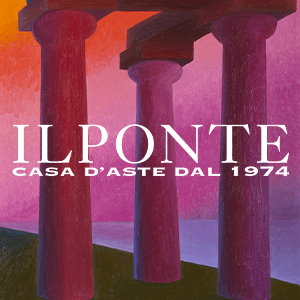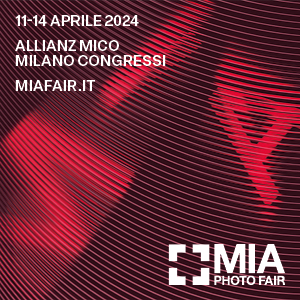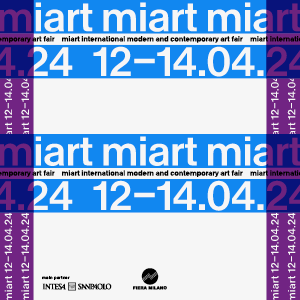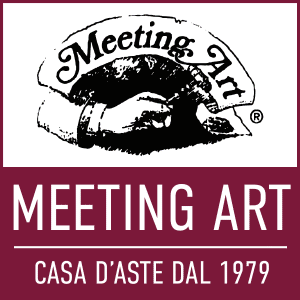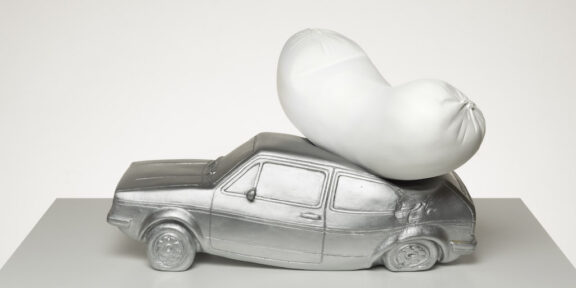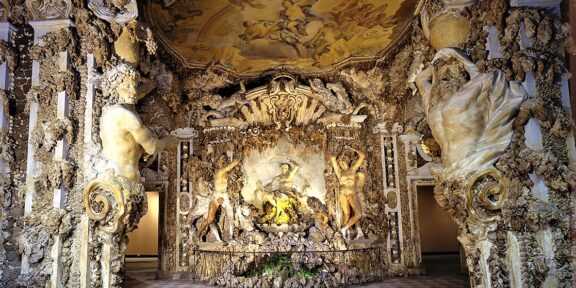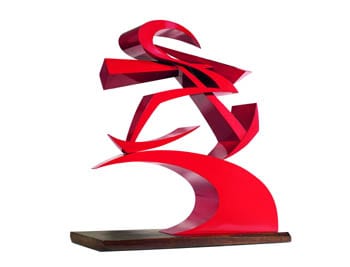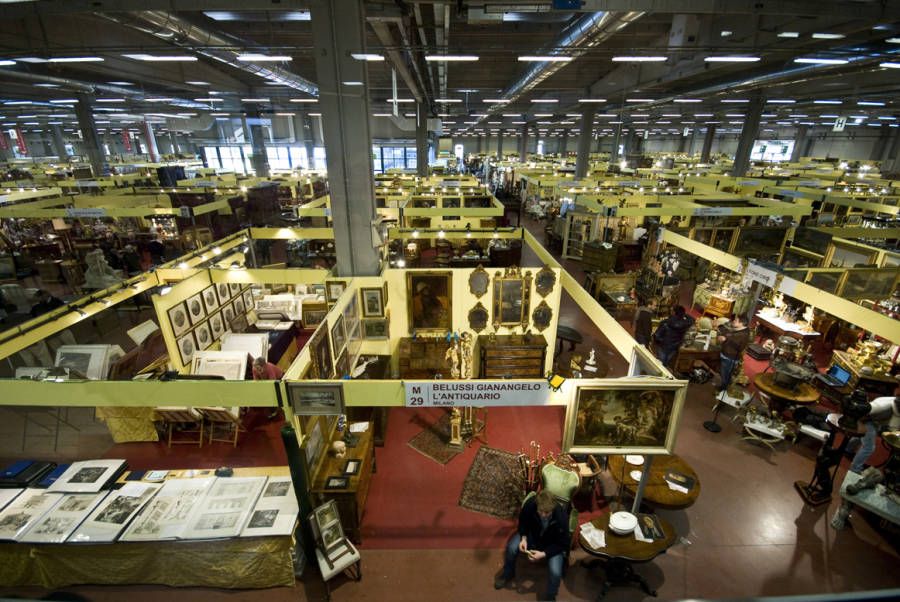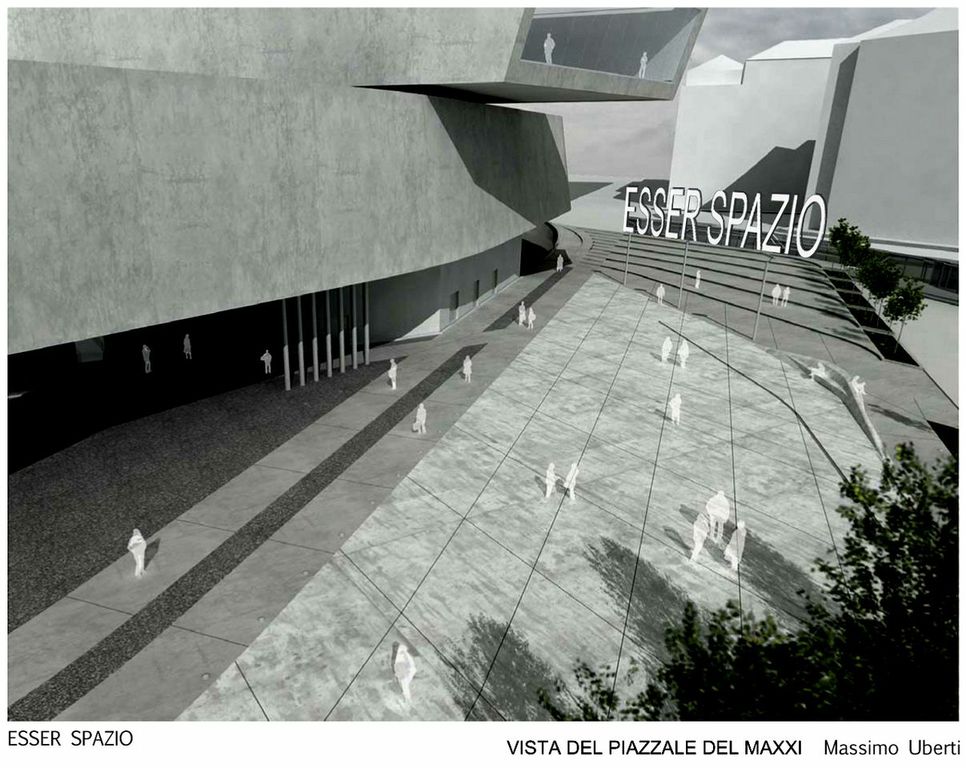
Erwin Wurm racconta la propria arte e della sua speciale relazione con la scultura; riflette attorno ai temi della nostra società e sui tempi controversi che stiamo vivendo, tutto questo in occasione del proprio solo show “Trans Formam” visitabile presso Galleria Poggiali a Firenze fino all’8 aprile.
Caterina Fondelli: Per quale motivo possiamo ritenere importante la mostra personale “Trans Formam” al momento ospitata da Galleria Poggiali a Firenze? Sia per te come artista, che per i fruitori e l’arte in generale.
Erwin Wurm: Il progetto in mostra è effettivamente un compendio della mia pratica. Di solito ho più di uno show in programma durante l’anno e non lavoro infatti specificatamente per un’esposizione, creo opere liberamente che in un secondo momento verranno sottoposte ad una selezione. Con Lorenzo, della Galleria Poggiali, abbiamo avuto uno studio visit durante il quale egli ha espresso il desiderio di includere nel progetto la Fat car, che era inizialmente destinata ad un’altra location. In “Trans Formam” si trova quindi un’unione di miei lavori come le sculture astratte (salsicce) e oggetti deformati come le macchine e le case. Ho anche realizzato dei dipinti che definisco ‘sculture piatte’, nelle quali compaiono parole connesse al resto del mio lavoro. Sono sempre stato interessato alla trasformazione dei volumi, delle masse, delle architetture tridimensionali, oggetti e volumi che crescono, e ho così provato a fare con i dipinti, che sono sì grandi, ma non “grossi”, li ho concepiti come ‘piattamente grandi’.
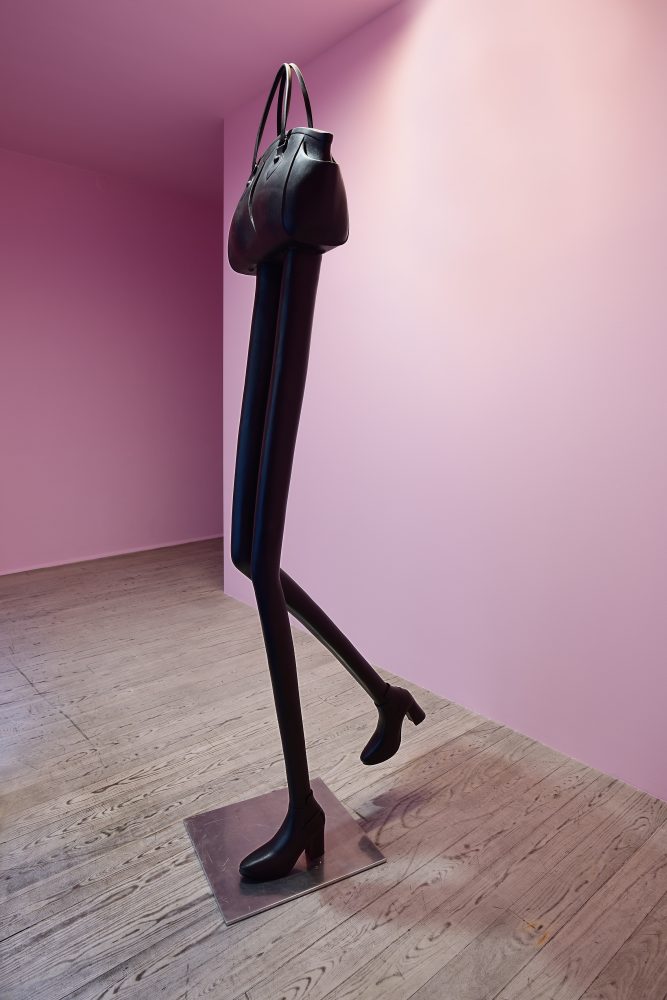
C.F.: Come definiresti la tua relazione con la scultura in questo specifico momento della tua esistenza e carriera, il suo legame inoltre con la società contemporanea?
E.W.: Seguo due linee generali nella mia poetica: una è il mio interesse per la scultura, esplorandone propriamente la sua stessa nozione, “Che cos’è una scultura?”; “Che cosa può essere?”; “Che cosa significa ai giorni nostri?”. Quando ho iniziato ad avvicinarmi all’arte, la scultura non mi colpiva e non mi entusiasmava. Sono stato inserito in un classe di scultura da giovane adulto, dopo aver sostenuto l’esame di ammissione all’Università. Inizialmente volevo in realtà diventare pittore, ma non ci sono riuscito, così ho cambiato visione e l’ho accolta come una sfida ponendomi continuamente interrogativi come quelli esposti sopra. Mi chiedevo “Che cosa significano i concetti di tridimensionalità, pelle, superficie, massa, volume o tempo?”.
Un’altra parte del mio lavoro riguarda l’interfacciarmi con problematiche sociali. Per esempio quando ci accingiamo a realizzare qualcosa in argilla aggiungiamo o togliamo volumi come accade alla corporatura. Il perdere o prendere peso è una specie di processo scultoreo che ci consente di fare esperienza della scultura nel quotidiano, di relazionarsi con i volumi e il contenuto che cambia che è veramente interessante. Così è nato il rapporto con la sfera sociale. Ho creato un video dove chiedevo ad un performer di indossare strati su strati di indumenti, un intero guardaroba. Lui iniziava così ad espandersi, a moltiplicare la propria superficie, attraverso questo processo a diventare una scultura lui stesso. Si tratta di un aspetto affascinante perché riguarda quello che facciamo ogni giorno, ci vestiamo e questo diviene così di fatto una questione sociale. Sono totalmente interessato alle domande “banali” come “Che cosa hai mangiato per colazione?”. Ho dedicato la mia intera vita a questa connessione fra scultura e vicende sociali.

C.F.: Una sezione della mostra fiorentina è dedicata a un tema molto investigato nella tua poetica: la casa. Qui presenti abitazioni di celebri e essenziali figure per la cultura, politica e scuole di pensiero. Per quale ragione hai optato per queste scelte nello specifico? E come consideri che il ruolo della casa come istituzione sociale sia cambiato negli ultimi 4 anni?
E.W.: Come sappiamo abbiamo la nostra pelle. I vestiti poi sono la nostra seconda pelle. La casa arriva come terzo strato protettivo e necessitiamo di esso, ci fa sentire al coperto e al caldo durante i freddi inverni, al fresco in estate, ci protegge da sguardi indiscreti. Ognuno di noi ha vissuto o vive da qualche parte. Il luogo dove abitiamo è anche simbolo dello status sociale posseduto, come avviene per gli indumenti, è segno di come vogliamo essere visti dagli altri.
Inoltre è presente il dramma dell’architettura, o meglio delle case costruite senza la presenza di un architetto, nella nostra società molte sono composte da parti prefabbricate industrialmente come porte, finestre etc. I miei genitori stessi vivevano in una casa di questo tipo ed essa è stata il mio modello, laddove ho imparato il confronto fra queste case e le altre più antiche. Non è una questione monetaria, bensì legata al senso estetico, al gusto, allo stile, quella che può essere chiamata una filosofia. Ho indagato molto questo fenomeno che è anche una piaga per le campagne, lesiva per l’identità, non solo per le anime e le menti delle persone, ma anche per le colture, visto che i materiali impiegati non permetto più a nulla di germogliare.
Concepisco le case da un ulteriore punto di vista, pensando a luoghi come il Guggenheim museum o gli edifici progettati da Mies van der Rohe, ho meditato sul fatto che la casa sia anche ciò che sta al suo interno: un’istituzione, una banca, una famiglia, un’azienda. Ho pensato perché non giocare con questi elementi, interno ed esterno, e perché non realizzare una casa “grassa”? Che risultato si può ottenere combinando il sistema biologico della crescita con il sistema architettonico della costruzione? L’esito è stato sorprendente per me.
Ho compreso che la casa ha un volto e che filosofi, scrittori o politici hanno vissuto in una casa. Ho voluto perciò rendere questo visibile e utilizzarlo. Ho così creato la casa natale di Sigmund Freud mentre si scioglie, o la casa di Karl Marx verso la quale ho dato la possibilità al pubblico di relazionarsi. Io le chiamo pezzi performativi in quanto quando li creo, performo qualcosa su di essi. La casa in vetro di Murano è interessante perché il vetro è un liquido, un liquido che fluisce lentamente, ed è stato immediato per me il riferimento al ghiaccio e l’ho dunque titolata Ice house.
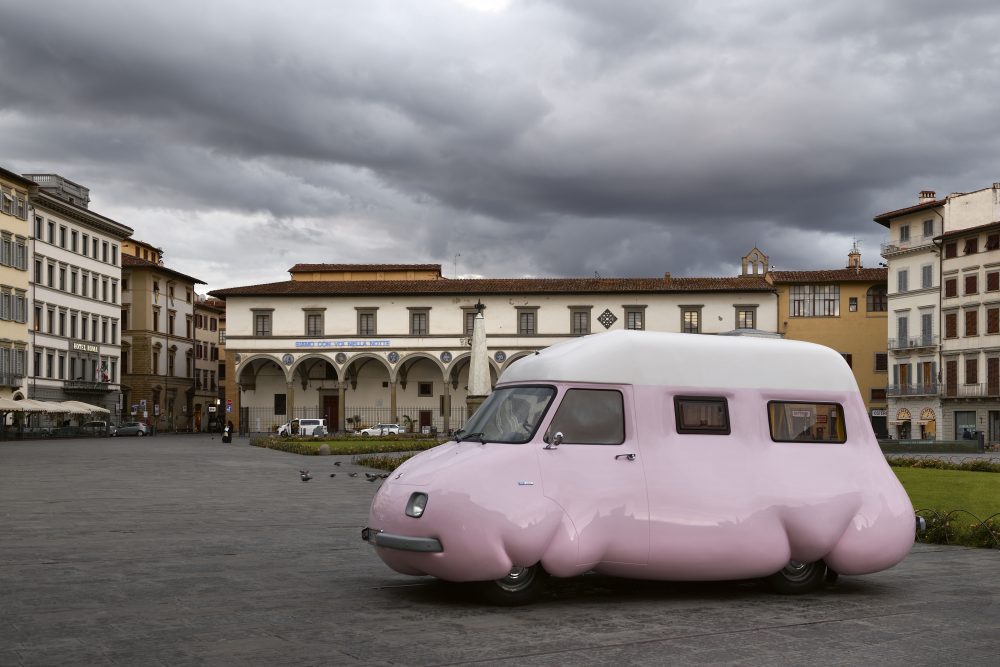
C.F.: Un altro interessante insieme di opere in “Trans Formam” è costituito da una serie di dipinti. Come li descriveresti? Ritieni questi lavori un nuovo punto di partenza per la tua ricerca?
E.W.: Possediamo una casa in Grecia, dove trascorro solitamente l’estate. è situata su un’isola chiamata Hydra dove si trovano molti artisti . Ero lì con un amico e c’era questo piccolo negozio dove si possono acquistare colori per dipingere nel tempo libero. Quest’idea del dipingere è arrivata all’improvviso, visto che non avevo mai dipinto prima. Mentre la concretizzavo mi è piaciuta moltissimo, mi sono abbandonato ad essa come ad un nuovo amore e perdura tuttora. Dieci grandi dipinti sono stati acquisiti di recente a Vienna e penso di portare avanti questa ricerca.
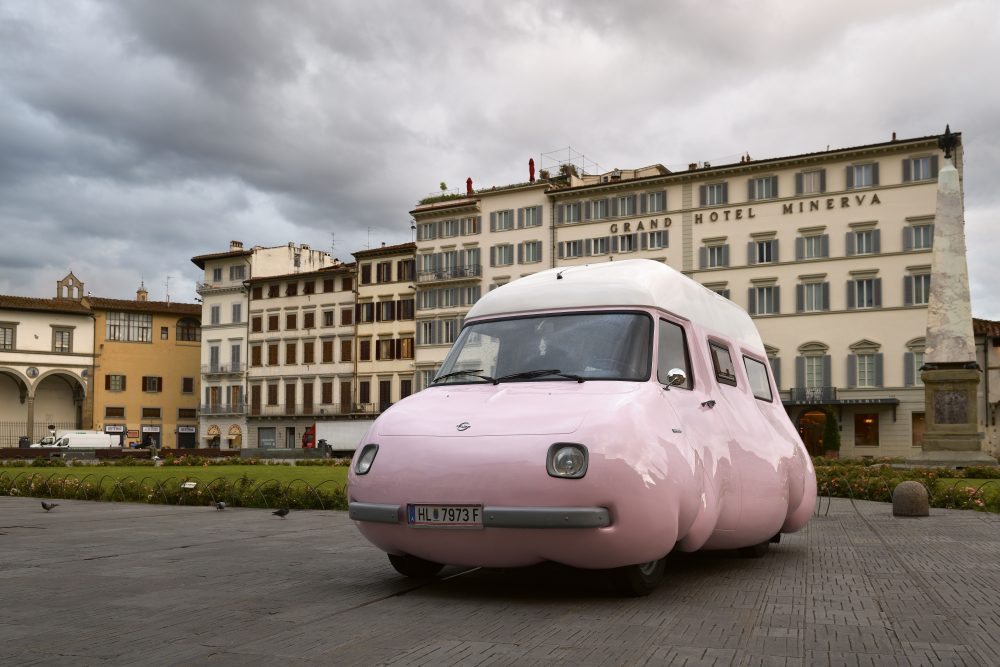
C.F.: Una domanda più ampia per concludere. In questi tempi molto complicati che stiamo attraversando, pensi che l’artista possa giocare un ruolo decisivo o abbia comunque un dovere di dire o fare qualcosa in particolare?
E. W.: Ritengo che gli artisti siano stati costantemente utilizzati impropriamente nel corso dell’intera storia, per esempio dai re, aristocrazia, rivoluzionari, socialisti, comunisti, da chiunque. È sempre stata presente un sorta di influenza da parte di qualche gruppo di persone, ed esse volevano attribuire all’arte il loro modo di immaginare le cose, come la loro visione in merito alla rappresentazione della grandezza, o per la chiesa quella del paradiso, e questa consuetudine si è trascinata fino ad oggi. Gli artisti continuano ad essere “abusati”, talvolta il giudizio dei critici o curatori impone un certo tipo di interpretazione. Penso che una condizione fondamentale sia la presenza di libertà. Insistiamo spesso sul fatto che l’arte debba avere in qualche modo un senso, mentro io credo che dovremmo creare cose senza senso, non inteso come qualcosa id stupido, ma che porti con sé un senso di libertà, per poter in tal modo uscire da questi confini così ristretti. D’altro canto viviamo in tempi tremendi e disapprovo totalmente la nostra società, come essa tratta il mondo, il clima, la natura, gli animali e se stessi.
Necessitiamo di un cambiamento nell’approccio e di ripensare i nostri ideali. Nonostante ciò, voglio che la mia arte si mantenga libera, la concepisco come se fosse una pianta rara e voglio prendermene cura perché nessuno ne abusi, in maniera religiosa, politica e così via. Come essere umano ho la mia opinione e prospettiva ben delineata sul futuro e la società, ma voglio tenere tutto questo separato da quello che faccio come artista.
LA VERSIONE INGLESE DELL’INTERVISTA
Erwin Wurm converse on his art, especially on his special relationship with sculpture, discussing also around our society and controversial times, on the occasion of the solo show “Trans Formam” on view at Galleria Poggiali in Florence until next April 8, 2023.
Caterina Fondelli: Why is the exhibition “Trans Formam”, your solo show currently on view at Galleria Poggiali in Florence, important? Both for you as an artist, for visitors and for Art in general.
Erwin Wurm: The project on view is actually a mixture of my work. I usually have many exhibitions throughout the year and almost never work specifically for a show. I develop my artworks freely and then decide which works to select. Lorenzo, from Galleria Poggiali, and I had a studio visit and he really wished to have on view the Fat car, a key work of mine, which was initially destined for another location. So, here we can find a variety of my works such as abstract sculptures (sausages) and deformed objects like cars and houses. I also made paintings which I call flat sculptures showing words mostly related to my general range of artworks. I was always interested in transforming volumes and masses and three-dimensional architecture, growing objects, growing volumes and so I tried to do with paintings, which can be ‘big’ but not ‘fat’ so I made them ‘flat big’.
C.F.: How would you define your relationship with sculpture in this specific moment of your existence and career and also the bond between sculpture and contemporary society?
E.W.: I have two general lines in my artistic work: one was the interest in sculpture by exploring the notion of sculpture, “What is it a sculpture?”; “What can it be?”; “What does it mean nowadays?” When I started getting interested in art, sculptures didn’t affect me and I was really not excited by them. As a young adult they put me into the sculpture class after I took the entry exam at my university. In the beginning I was therefore somehow forced to explore sculpture. I actually wanted to become a painter but they didn’t allow me, so I had to change my perception and I tried to take it as a challenge and continuously asked myself questions like the ones I told before. I asked myself: “What does three-dimensionality, skin, surface, mass, volume or time mean?”. Another part of my work is that I started to face social matters. So, for instance when you make something in clay you add volume or take volume away, as we do with our body and weight. Gaining or losing weight is a kind of sculptural work that makes us experience sculpture in the everyday. It makes us deal with volume and content changes which is truly interesting. I made a video where I asked a performer to put on layers and layers of clothes, an entire wardrobe. He became very big, he was multiplying his surface and through this process became a sculpture himself. This is an interesting aspect since we do it daily. We dress up and this all of a sudden becomes a social issue. I am totally interested in the little questions like “What do you eat for breakfast?”. I devoted my entire life to the connection between sculpture and social issues.
C.F.: A section of the Florentine exhibition is dedicated to a theme you deeply investigated, the house. Here you present places home of very famous and pivotal figures of culture, politics and thinking. Why did you opt for choosing them specifically? And how do you think the function of the house as a social institution has been changed in the last 4 years?
E.W.: You know we have skin. Our clothes are the second skin. The house comes as the third layer of protection and we need it, we feel covered and protected from the cold in the winter, cooled during the summer, we feel protected from the looks. Everybody lives or lived somewhere. The place where you live is a symbol of status as well as the clothes you’re wearing. It is a signature for others on how you want to be seen. Additionally, we have this drama of architecture and housing built without architects, in contemporary society many of them are made up of prefabricated industrialized standard pieces such as doors, windows and so on. My parents too lived in such a house and this was the reference for me to make a comparison between these kinds of houses and the old ones. It is not a matter of money, but it has more to do with aesthetics, taste, style, we can call it a philosophy. I studied a lot about this phenomenon that is also a plague on the countryside and destroyed the identity, not only the soul and mind of the people, but also the ground due to the materials used not consent to thriving things anymore.
I also considered houses from another perspective, I started to think about places like the Guggenheim museum or Mies van der Rohe buildings, and I meditated on the fact that a house is also what is inside of it: an institution, a bank, a family, a company. I thought, what if I would play around with these things, the inside and the outside and what if I make a house ‘fat’? what is the result when I combine that biological system of growing with the architectural system of the house? The outcome was very surprising for me. It turned out that houses have a face and I asked myself if you see that philosophers, writers or politicians lived in a house? What can I do to make it visible and can I play with this? And so I made the birth house of Sigmund Freud that is melting down, or the house of Karl Marx with which I gave to people the possibility to relate to it. I call them performative pieces since I created them by performing on them. The murano glass house is interesting too because glass is liquid, a very slowly floating liquid and immediately the reference to ice came to my mind so I titled it Ice house.
C.F.: Another interesting group of works in “Trans Formam” is made up of a series of painting. How would you describe them? Do you consider these artworks a new starting point in your own research?
E.W.: We have a house in Greece, where I usually spend my summers at. It is on an island called Hydra where many artists are located. I was there with a friend of mine and we passed a little shop where you can buy hobby paint. All of a sudden, the idea came up to paint, since I have never painted before. While painting I liked it so much. I fell into it. It became like a new love and I am continuing now. Ten big paintings have just recently been bought in Vienna and I think I will keep on with this research.
C.F.: A wider question to conclude. In these very complicated times we are all going through, do you think the artist could play a decisive role or has the duty to saying / doing anything particular?
E.W.: I think artists have always been misused in the entire history, for example by the kings, aristocracy, revolutionaries, socialists, communists, by everybody. There was always an influence by a certain group of people and they wanted to see art as they had imagined, like a representation of a certain idea of greatness, of the church, of heaven and this process continues until now. Artists are still misused, by the judgment of critics or curators who sometimes impose their visions. I think that the most important point is the presence of freedom. Another topic we stress is that art has to make sense in some way, however I think we should create senseless art, nonsense art, that doesn’t have to do with stupidity but with a freedom of sense, in order to be pulled out by these strict boundaries.
On the other hand, we live in such terrible times and I really disapprove of our society, how we treat our world, climate, nature, animals, us, and that’s horrible and we need to change our approach and to rethink our concepts. Despite this I want my art to keep itself free. I conceive it like a rare plant I would like to care for and not to be misused by religion, in terms of politics and so on. As a human being I have my precise opinion and perspective about our future and society, but it is separated from what I do as an artist.





